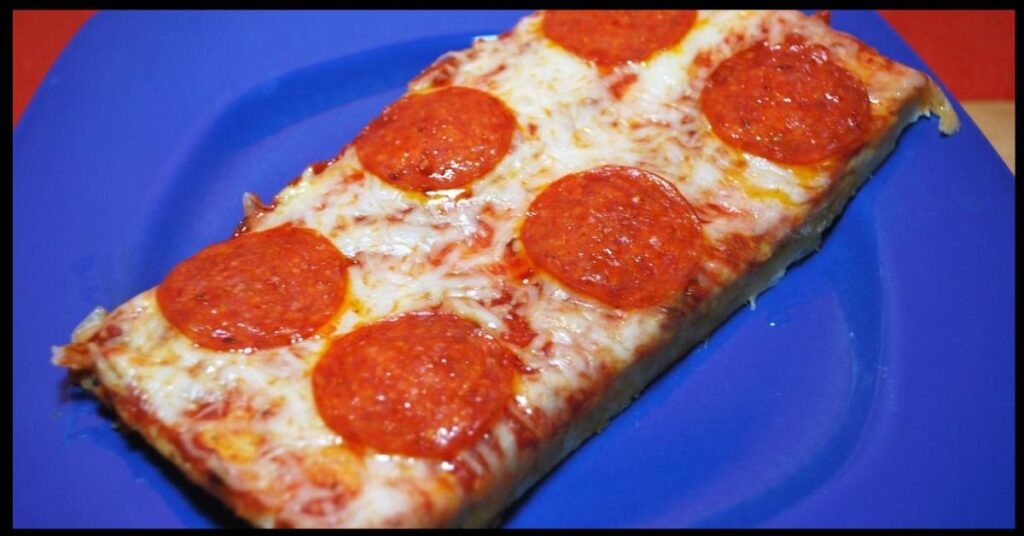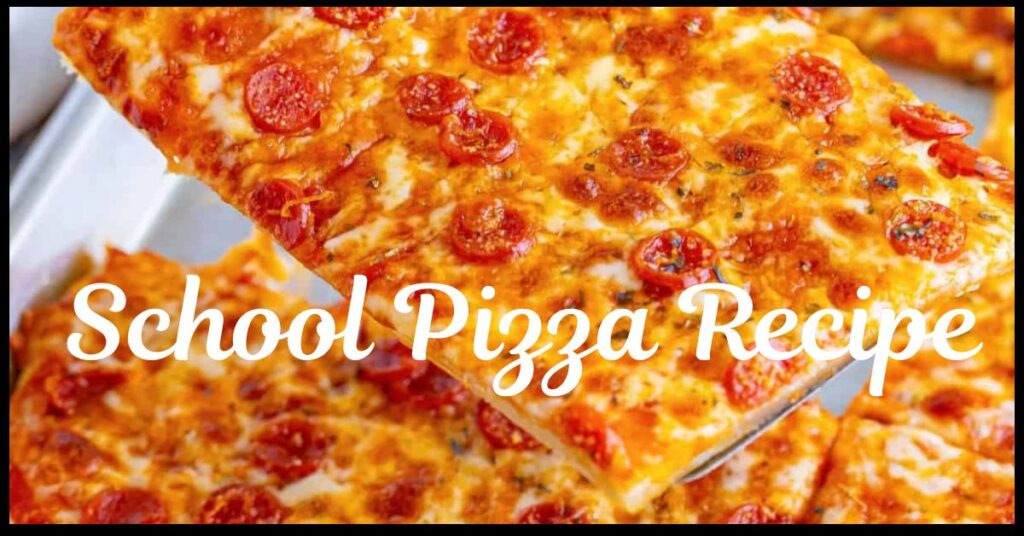The classic school pizza recipe brings back fond memories for many who grew up eating those thick, rectangular slices served in the cafeteria. Known for its fluffy crust, tangy tomato sauce, and generous cheese topping, this nostalgic dish remains a beloved favorite. Recreating this old-school cafeteria pizza at home is easier than it seems. This guide provides a step-by-step process to make a delicious and authentic homemade school pizza, perfect for family meals, parties, or simply reliving childhood memories.
Table of Contents
ToggleThe History of School Pizza
In the 1970s and 1980s, school lunch programs across the United States started offering pizza as part of their menus. According to the USDA, school lunches were designed to meet specific nutritional guidelines, ensuring students received balanced meals (source: USDA Food and Nutrition Service). School pizza typically featured a thick, bread-like crust, simple tomato sauce, and modest toppings to keep it nutritious and cost-effective.
Today, the charm of vintage pizza recipes lies in their simplicity and hearty flavor, making them a popular homemade treat.
Essential Ingredients for School Pizza
To recreate the authentic school pizza, use the following basic ingredients:
- Flour: All-purpose flour works well to create the thick, soft crust.
- Yeast: Active dry yeast is ideal for getting a light, airy dough.
- Sugar: A small amount helps activate the yeast and adds mild sweetness.
- Salt: Essential for flavor enhancement.
- Water: Warm water activates the yeast.
- Oil: Vegetable or olive oil to keep the dough soft.
- Tomato Sauce: Use a simple, seasoned tomato sauce or marinara.
- Cheese: Mozzarella cheese is the classic choice, sometimes combined with cheddar.
- Toppings (Optional): Pepperoni, sausage, mushrooms, or bell peppers.
Using quality ingredients ensures the final pizza is flavorful and close to the school cafeteria classic.

Step-by-Step School Pizza Recipe
1. Prepare the Dough
Ingredients for Dough:
- 2½ cups all-purpose flour
- 1 packet (2¼ teaspoons) active dry yeast
- 1 teaspoon sugar
- 1 teaspoon salt
- 1 cup warm water (110°F)
- 2 tablespoons vegetable oil
Instructions:
- In a bowl, dissolve sugar and yeast in warm water. Let it sit for 5–10 minutes until foamy.
- Add flour, salt, and oil. Mix until a dough forms.
- Knead the dough on a floured surface for about 5–7 minutes until smooth and elastic.
- Place the dough in an oiled bowl, cover, and let it rise in a warm spot for 45 minutes to 1 hour, or until doubled in size.
2. Make the Pizza Sauce
Simple Sauce Ingredients:
- 1 cup canned tomato sauce
- 1 teaspoon dried oregano
- ½ teaspoon garlic powder
- ½ teaspoon onion powder
- ½ teaspoon sugar (optional)
Instructions:
- Combine all ingredients in a small saucepan.
- Simmer on low heat for 10–15 minutes, stirring occasionally.
- Allow the sauce to cool slightly before spreading on the dough.
3. Assemble the Pizza
Instructions:
- Preheat the oven to 450°F (232°C).
- Grease a 9×13-inch baking sheet or line it with parchment paper.
- Roll out the risen dough into a rectangle and place it on the prepared sheet.
- Spread a generous layer of sauce over the dough, leaving a small border around the edges.
- Sprinkle mozzarella cheese evenly over the sauce. Add optional toppings if desired.
4. Bake and Serve
Instructions:
- Bake the pizza for 15–18 minutes or until the cheese is melted and bubbly, and the crust is golden brown.
- Let the pizza cool slightly before cutting into classic rectangular slices.
- Serve warm and enjoy the nostalgic flavors.
Tips for Perfect Homemade School Pizza
- Use Bread Flour: For an even chewier crust, substitute bread flour for all-purpose flour.
- Let the Dough Rise Properly: A warm, draft-free environment helps the dough rise faster and evenly.
- Customize Toppings: While traditional school pizza was simple, adding toppings like turkey pepperoni or extra veggies keeps it both fun and nutritious.
- Double the Recipe: The dough can be doubled to make a larger pizza or multiple pans for gatherings.
Nutrition Facts (Approximate per Slice)
| Nutrient | Amount |
|---|---|
| Calories | 250-300 |
| Protein | 12g |
| Carbohydrates | 30g |
| Fat | 10g |
| Fiber | 2g |
Nutrition values vary based on ingredients and portion size.
According to the USDA Food Database, these estimates fit within typical school meal standards, providing a balance of macronutrients.

Why School Pizza Remains Popular
The enduring appeal of old-school cafeteria pizza comes from its:
- Simplicity: Basic ingredients make it easy to prepare at home.
- Comfort Food Status: Many associate it with positive childhood memories.
- Versatility: It can be adapted with different sauces, cheeses, and toppings.
- Affordability: Ingredients are cost-effective, making it ideal for families.
Modern versions also cater to different dietary needs, including gluten-free and dairy-free options.
Variations of School Pizza
- Breakfast Pizza: Substitute traditional toppings with scrambled eggs, sausage, and cheddar cheese.
- Vegetarian Pizza: Load up the pizza with mushrooms, bell peppers, onions, and spinach.
- Cheesy Garlic School Pizza: Add a layer of garlic butter and extra mozzarella for a rich, savory version.
Experimenting with different toppings keeps the classic school pizza exciting and tailored to personal tastes.
Conclusion
Recreating the classic school pizza recipe at home is a rewarding and delicious experience. With simple ingredients and easy steps, anyone can bring the taste of the cafeteria into their kitchen. Whether made for a family dinner, a school-themed party, or just for fun, this homemade school pizza offers a slice of nostalgia that everyone can enjoy.
For those looking for a satisfying, hearty, and memorable meal, nothing beats a warm, cheesy piece of vintage school cafeteria pizza.







